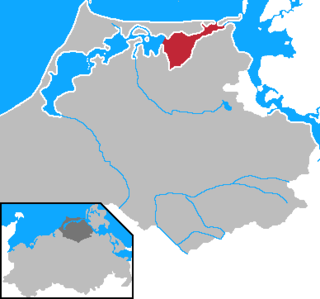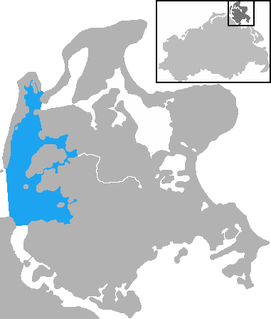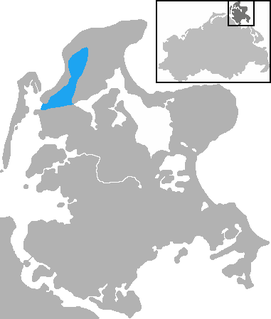
Rügen is Germany's largest island by area. It is located off the Pomeranian coast in the Baltic Sea and belongs to the state of Mecklenburg-Western Pomerania.

The Western Pomerania Lagoon Area National Park is Mecklenburg-Vorpommern's largest national park, situated at the coast of the Baltic Sea. It consists of several peninsulas, islands and lagoon shore areas in the Baltic Sea, belonging to the district of Vorpommern-Rügen.

Hiddensee[ˈhɪdn̩zeː](listen) is a car-free island in the Baltic Sea, located west of Germany's largest island, Rügen, on the German coast.

The island of Ummanz lies in the Baltic Sea, off the west coast of the island of Rügen, and belongs, like the latter, to the county of Vorpommern-Rügen in the German state of Mecklenburg-Western Pomerania.

Fischland-Darß-Zingst or Fischland-Darss-Zingst is a 45 km (28 mi) long peninsula in the coastal district of Vorpommern-Rügen, in the German state of Mecklenburg-Vorpommern. The three parts of the peninsula, from west to east, are Fischland, Darß and Zingst.

Bodden are briny bodies of water often forming lagoons, along the southwestern shores of the Baltic Sea, primarily in Germany's state of Mecklenburg-Vorpommern. These lagoons can be found especially around the island of Rügen, Usedom and the Fischland-Darss-Zingst peninsula. Some of them are protected reserves, forming the Western Pomerania Lagoon Area National Park.
Vorpommern-Rügen is a district in the north of Mecklenburg-Vorpommern, Germany. It is bounded by the Baltic Sea and the districts Vorpommern-Greifswald, Mecklenburgische Seenplatte and Rostock. The district seat is the Hanseatic city of Stralsund.

The Darss-Zingst Bodden Chain is a waterbody on the Baltic Sea coast northeast of Rostock in Germany. It consists of a string of several lagoons or bodden arranged in an east-west direction that are separated from the open sea by the Fischland-Darß-Zingst peninsula. The surface area of these lagoons is 197 km² and the average water depth is only about two metres.

The Großer Jasmunder Bodden belongs to the Northern Rügener Boddens and is a water body on the southern edge of the Baltic Sea in the German state of Mecklenburg-Vorpommern. It is a bodden, a type of lagoon that occurs in northern Europe especially on the coast of Pomerania. It lies within the island of Rügen, is around 14 kilometres long, an average of six kilometres wide and is up to nine metres deep with an average depth of 5.3m. The Großer Jasmunder Bodden has an area of 58.6 square kilometres; if the Breetzer Bodden, Breeger Bodden, Lebbiner Bodden, Neuendorfer Wiek and Tetzitzer See are included the total area of water comes to over 94 square kilometres.

The Schaproder Bodden is a bodden on the Baltic Sea coast between the island of Hiddensee in the west and the islands of Rügen and Ummanz in the east. To the north the Schaproder Bodden is linked to the Vitter Bodden by the so-called Trog between the Fährinsel and the Stolper Haken of Rügen island. To the south the bodden transitions into the Kubitzer Bodden. A boundary would be the line between the southern tips of the Hiddensee and Ummanz or the link from the Geller Haken - Insel Heuwiese.

The Grabow is a bodden - a lagoon-like waterbody - off the Baltic Sea south of the Zingst and Großer Werder peninsulas and the island group of Kleiner Werder.

The West Rügen Bodden are a string of lagoons and embayments, known as bodden, in Western Pomerania on the Baltic Sea coast. They lie in the Western Pomerania Lagoon Area National Park west and southwest of the island of Rügen, and east and southeast of Hiddensee.

The Udarser Wiek is a bay on Germany's Baltic Sea coast, about 8 km² in area, between the islands of Rügen in the north and Ummanz in the south. In the west, the bodden transitions into the Schaproder Bodden and in the southeast to the Gahlitz in the lake of Koselower See. At the northeast end of the bay lies the island of Öhe.

The Kubitzer Bodden is a type of lagoon known as a bodden on the Baltic Sea coast in the southwestern area of the island of Rügen in Germany. In the north the bodden is bounded by the Lieschow peninsula on Rügen. In the east and south the shores of the island of Rügen near Dreschvitz, Samtens and Rambin form its natural perimeter. The boundary with the Strelasund to the west is the line between the hook known as the Bessiner Haken near Bessin in the south and the tip of the Lieschow peninsula in the north.

The peninsula of Großer Werder lies southwest of the Hiddensee, west of the island of Bock and is joined to the peninsula of Zingst to the east. It belongs to the district of Vorpommern-Rügen in northeast Mecklenburg-Vorpommern in Germany.

The Wieker Bodden is a lagoon or bodden, that is largely surrounded by the German Baltic Sea island of Rügen. It is part of the North Rügen Bodden Chain.

Bug is the name both of the westernmost tongue of land (Landzunge) on the peninsula of Wittow on the German island of Rügen, as well as the name of the former village there. Bug begins south of the village of Dranske and belongs territorially to that municipality.

The Zudar is a peninsula on the German Baltic Sea island of Rügen. It is about 18 square kilometres in area and sharply divided.

Fährinsel is a small Baltic Sea island off the eastern shore of the island of Hiddensee and which belongs to the Insel Hiddensee municipality. It is separated from Hiddensee by the narrow Bäk, only 120 metres wide in places. It forms the western part of the border between the Schaproder Bodden and the Vitter Bodden. The island is 1.23 km long and up to 580 metres wide. It has an area of ca. 37 ha. Ferry services between Rügen and Hiddensee used to run via Fährinsel. It was closed in 1952 when the port at Schaprode was upgraded to handle mailboat services. Fährinsel is a nature reserve and out-of-bounds to visitors. It is a roosting place for thousands of birds and the grazing area for a herd of Gotland sheep.

The Lake Tetzitz, Liddow Peninsula and Banzelvitz Hills Nature Reserve is a nature reserve, 1,088 hectares in area, on the German island of Rügen in Mecklenburg-Western Pomerania. It was officially designated as such on 5 November 1990 and expanded in 1994. Nearby villages are Neuenkirchen and Rappin. The area under protection is a section of the North Rügen Bodden which has a great variety of habitats and is an important roosting and breeding area for the bird world. The elements that give the reserve its name are Lake Tetzitz in the west, the peninsula of Liddow in the centre and the Banzelvitz Hills in the eastern part of the nature reserve. Lake Tetzitz is linked to the Großer Jasmunder Bodden by the channel of the Liddow Strom.



















